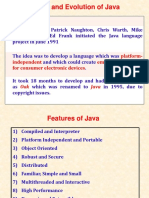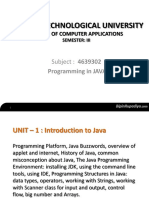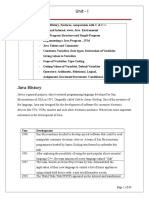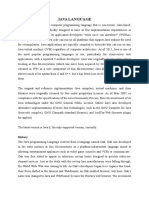Introduction To JAVA
Introduction To JAVA
Uploaded by
bhfrCopyright:
Available Formats
Introduction To JAVA
Introduction To JAVA
Uploaded by
bhfrOriginal Title
Copyright
Available Formats
Share this document
Did you find this document useful?
Is this content inappropriate?
Copyright:
Available Formats
Introduction To JAVA
Introduction To JAVA
Uploaded by
bhfrCopyright:
Available Formats
Introduction to JAVA
Mr. Prashant Kulkarni
Java is an Object Oriented Programming Language.
History of JAVA:
In 1991, a Group of Sun Engineers (Patrick Naughton & James Gosling)
wanted to design a computer language
used to write programs
for consumer electronic devices.
These devices do not have lot of power or memory,
So,
The language had to be small & generate very tight code.
Also,
Different manufacturer may choose different CPU/Platform.
So,
It was important that the language is independent of CPU architecture.
This project was named as “Green”.
Mr. Prashant Kulkarni
The Sun team constructs a model that generates an intermediate code.
Then,
This intermediate code could be used on any machine
that had the correct interpreter.
The model is called as JVM (Java Virtual Machine).
The Sun peoples are come from UNIX background.
So,
Their new language based on C++ i.e. Object Oriented
James Gosling decided to call this language as “Oak”.
But later,
The team realized that Oak was the name of an existing language,
So,
They changed the name to “JAVA”.
Mr. Prashant Kulkarni
In 1992,
The Green project delivered its first version, called “*7”.
Unfortunately,
No one was interested to use this for their product
The team spends all 1993 and half 1994 looking for people to buy its
technology. But no one found.
During same period,
The World Wide Web (WWW) part of Internet was growing bigger and
bigger.
The key to this web is “Browser” that translates the hypertext page to web
screen.
Mr. Prashant Kulkarni
In 1994,
Gosling Team realized that they could build a browser
that needs some things to be wired
i.e.
Architecture Neutral,
Real Time, Reliable,
and Secure.
So,
Patrick Naughton & Team build a browser known as “HotJava” browser.
This browser was written in Java to show the power of Java.
This browser also had Power of Applet and it is capable of executing
code inside web pages.
Mr. Prashant Kulkarni
FEATURES OF JAVA (BUZZWORDS):
1) Simple
2) Object Oriented 9) High Performance
3) Distributed
10) Multithreaded
4) Reliable or Robust
5) Secure 11) Dynamics
6) Architecture Neutral
7) Portable
8) Interpreted
Mr. Prashant Kulkarni
1) Simple: -
It is primary characteristic of Java programming language.
The syntax for Java is some what similar to syntax of C++.
There is no need for header files, pointer arithmetic, structures,
union, operator overloading, virtual base class & so on.
Another aspect of being simple is that it required a basic interpreter &
class support for executing a Java program.
2) Object Oriented: -
Object oriented design is a technique for programming that focuses on
data.
Java provides clean & efficient object based development platform.
Programmers can access existing libraries of tested objects that provide
functionality ranging from basic data types to Graphical User Interface
Toolkits. Mr. Prashant Kulkarni
3) Distributed: -
Java has extensive libraries of routines for copying with TCP/IP
protocols like HTTP & FTP.
Java applications can open & access objects across the network.
The networking capabilities of Java are strong & easy to use.
The remote method invocation mechanism enables communication
between distributed objects.
Hence we say that Java is distributed.
Mr. Prashant Kulkarni
4) Robust (Reliable): -
Java programming language is designed for highly reliable software.
It provides extensive compile-time checking,
followed by a second level of run-time checking.
The memory management model is extremely simple.
Here objects are created with a new operator.
There is no explicit user-defined pointer data types, no pointer
arithmetic.
Java has a pointer model that eliminates the possibility of overwriting
& corrupting data, because it has automatic garbage collection.
Mr. Prashant Kulkarni
5) Secure: -
As java designs a program that is operate in distributed environments.
So,
Security is very important point.
Java technology lets you construct applications that can’t be invaded
from outside.
In network environment, applications written in the java programming
language are secure from intrusion by unauthorized code.
Mr. Prashant Kulkarni
6) Architecture Neutral: -
Java technology is designed to support applications that will be
executing on different network environments.
Java compiler produces bytecode, an intermediate code designed to
execute efficiently for multiple hardware & software platforms.
The same Java bytecode can run on any platform by using Java Virtual
Machine (JVM).
Mr. Prashant Kulkarni
7) Portable: -
Java technology specifies the size of the basic data types and the
behavior of its arithmetic operators.
Your Java program is same on every platform, and there are no data
incompatibilities across hardware and software architectures.
e.g.
An int type in java is always of 32 bits,
In C/C++,
It can be 16 bits or 32 bits depends on compiler vendors.
e.g.
There is an Abstract Window Toolkit Classes and its implementations on
UNIX, Windows, and Macintosh is same.
Mr. Prashant Kulkarni
8) Interpreted: -
Java Interpreter can execute Java byte codes directly on any machine.
In Java technology the linking is incremented and lightweight.
So,
The development process can be much more rapid and exploratory
than the traditional compile – link – execute process.
9) High Performance: -
The Java platform achieves superior performance
By
The automatic garbage collector runs a low priority background
process,
So that
More memory is available when required leading to better performance.
Mr. Prashant Kulkarni
10) Multithreaded: -
Java provides the way to build an application with many concurrent
activities i.e. called as threads.
So,
It results in interactivity for the end user.
The Java language provides a class Thread and run-time system provides
monitors and condition lock for different threads running concurrently.
Thread in java also has advantage of multiprocessor system if base OS
support it.
Mr. Prashant Kulkarni
11) Dynamic: -
Java is more dynamic language than any other i.e. C or C++.
The libraries can freely add new methods and instance variables
without any effect to their clients.
The Java run-time system is dynamic in their linking stages.
Classes are linked only as needed. New code modules can be linked as
per demand from variety of sources, even from across the network.
Mr. Prashant Kulkarni
JAVA DEVELOPMENT KIT (JDK):
The Java Development Kit (JDK) is a Sun Microsystems product for
Java developers.
The primary components of the JDK are a selection of programming
tools, like…
java: - The loader for Java applications.
This tool is an interpreter and can interpret the class files
generated by the javac compiler.
javac: - The compiler, which converts source code into Java
bytecode.
jar: - The archiver, which packages related class libraries into a
single JAR file. This tool also helps managing jar files
(archived java class files).
The JDK also contains complete Java Runtime Environment.
It contains JVM and all of the class libraries.
Mr. Prashant Kulkarni
JAVA VIRTUAL MACHINE (JVM):
A Java Virtual Machine (JVM) is a set of software programs
and data structures which used for the execution of other computer
programs and scripts.
The model used by a JVM accepts a form of computer intermediate
language commonly referred to as Java bytecode.
JVM operate on Java bytecode, generated from Java source code.
The JVM is a crucial component of the Java Platform.
The use of the same bytecode for all platforms allows Java to be
described as "compile once, run anywhere“.
Mr. Prashant Kulkarni
You might also like
- Benelli TNT300 Service Manual FINAL (387-488)Document102 pagesBenelli TNT300 Service Manual FINAL (387-488)alex gavrishev100% (5)
- Student Management SystemDocument73 pagesStudent Management SystemManoj Kumar Jawlia75% (4)
- IP Project File CLASS 12Document33 pagesIP Project File CLASS 12S.r.Siddharth29% (28)
- Chap1introduction To JavaDocument13 pagesChap1introduction To Javachandrakantdake86No ratings yet
- The Better Way Is Here Now: Programming Language Platform From SunDocument6 pagesThe Better Way Is Here Now: Programming Language Platform From Sunkirankrish113734No ratings yet
- Java - Features PDFDocument15 pagesJava - Features PDFVinod AgarkarNo ratings yet
- Unit I Introducation and Overview JavaDocument34 pagesUnit I Introducation and Overview Javashantanujoshi445No ratings yet
- Notes On Java August 2024Document58 pagesNotes On Java August 2024Íni Ø BóñgNo ratings yet
- Chapter 1 IntroductionDocument7 pagesChapter 1 Introductionlemajambo7No ratings yet
- Unit 1Document123 pagesUnit 123r11a05x8No ratings yet
- Features of Java Programming LanguageDocument7 pagesFeatures of Java Programming LanguageAbhijit BanerjeeNo ratings yet
- JAVA Unit 1Document57 pagesJAVA Unit 1Principal SSIT, G'nagarNo ratings yet
- Lesson1 - Introduction To JavaDocument3 pagesLesson1 - Introduction To Javajm detorres029No ratings yet
- Java Programming: Basic Syntactical Constructs in JavaDocument41 pagesJava Programming: Basic Syntactical Constructs in JavasahilNo ratings yet
- Unit 1Document40 pagesUnit 1ranajitsenkoNo ratings yet
- ilovepdf_mergedDocument47 pagesilovepdf_merged202310943No ratings yet
- Module 1 Study GuideDocument9 pagesModule 1 Study Guide202310943No ratings yet
- JAVA - MCA 2024 - UNIT 1-StudentDocument113 pagesJAVA - MCA 2024 - UNIT 1-Studentdajij82325No ratings yet
- Elective I Java Programming NotesDocument219 pagesElective I Java Programming Notessomany12No ratings yet
- ADT LabDocument63 pagesADT LabAnuj Kumar ReyNo ratings yet
- Chapter 2Document25 pagesChapter 2minaketann3No ratings yet
- 1 1 Chapter 1 Introduction To Java ProgrammingDocument21 pages1 1 Chapter 1 Introduction To Java Programmingnevak97071No ratings yet
- Industrial Training ReportDocument38 pagesIndustrial Training ReportBhanu Pratap RajNo ratings yet
- Java UNIT 1-1Document36 pagesJava UNIT 1-1Malik JubranNo ratings yet
- Java History: Us06Ccsc01 Unit - I OOP Using JavaDocument69 pagesJava History: Us06Ccsc01 Unit - I OOP Using JavahkgraoNo ratings yet
- Java Unit1 LanguagebasicsDocument59 pagesJava Unit1 LanguagebasicsLaxmi Computer Science and EngineeringNo ratings yet
- Java Unit-1 FinalDocument21 pagesJava Unit-1 Finalrajfelix1969No ratings yet
- Object Oriented Prog With JAVADocument115 pagesObject Oriented Prog With JAVAChirag BhatiNo ratings yet
- Java Unit 1Document23 pagesJava Unit 1SrinivasaRao JJNo ratings yet
- Java Basics 1 - Chapter OneDocument33 pagesJava Basics 1 - Chapter Onedilankasilva86No ratings yet
- Introduction To JavaDocument42 pagesIntroduction To JavaSoumya VijoyNo ratings yet
- CS2305 PP Lecture Notes PDFDocument367 pagesCS2305 PP Lecture Notes PDFVijai KirubaNo ratings yet
- Introduction To Java ProgrammingDocument4 pagesIntroduction To Java ProgrammingAnupam Mani TripathiNo ratings yet
- Brick Game: Midterm Report ONDocument12 pagesBrick Game: Midterm Report ONManwinder Singh GillNo ratings yet
- JavaDocument187 pagesJavapramodmauryapkNo ratings yet
- Java Imp Question With AnswersDocument14 pagesJava Imp Question With Answerskeerthi47745No ratings yet
- Java Unit-1 R&RDocument40 pagesJava Unit-1 R&Rvinaydarling063No ratings yet
- 220245-MSBTE-22412-Java (Unit 1)Document40 pages220245-MSBTE-22412-Java (Unit 1)Nomaan ShaikhNo ratings yet
- Core JavaDocument7 pagesCore JavaChander ThukralNo ratings yet
- Features of JavaDocument5 pagesFeatures of JavamanoharNo ratings yet
- ReportDocument17 pagesReportabcdefghNo ratings yet
- Java Programming - Unit I Java: SS Govt. Arts CollegeDocument15 pagesJava Programming - Unit I Java: SS Govt. Arts CollegeaaimscaNo ratings yet
- 1 IntroDocument22 pages1 IntroChetan laddhaNo ratings yet
- 2 Java Intro and FeaturesDocument10 pages2 Java Intro and Featuresadit.jain606No ratings yet
- Oop CH 1-2Document29 pagesOop CH 1-2makkakuldipNo ratings yet
- What Do You Mean by SoftwareDocument185 pagesWhat Do You Mean by Softwaresaumitra ghogaleNo ratings yet
- Unit No.1Document47 pagesUnit No.1Omkar mahamuni0% (1)
- Advantages of JavaDocument6 pagesAdvantages of JavaSubodh SonawaneNo ratings yet
- Module 2-Introduction To JAVADocument29 pagesModule 2-Introduction To JAVAJayanth Vasudev50% (2)
- 22cs202-Unit 1 - PPTDocument153 pages22cs202-Unit 1 - PPTsamsundar793No ratings yet
- Chapter 1 Basic Syntactical ConstructsDocument58 pagesChapter 1 Basic Syntactical ConstructsHarish KhojareNo ratings yet
- Java 8 Year Question PaperDocument98 pagesJava 8 Year Question PaperKavyashree BNo ratings yet
- Unit IDocument5 pagesUnit IChuNo ratings yet
- Chapter 1 Java FeaturesDocument33 pagesChapter 1 Java Featuresvicky krrNo ratings yet
- JavaDocument314 pagesJavasleepingpal2No ratings yet
- Java Full Notes Unit 1-6 V2V by Rajan SirDocument156 pagesJava Full Notes Unit 1-6 V2V by Rajan SirYash GawareNo ratings yet
- JAVADocument34 pagesJAVAkoval31759No ratings yet
- JAVA Reference MaterialDocument148 pagesJAVA Reference Materialjyothijyo0309No ratings yet
- Introduction To Java: JAVA Was Developed by James Gosling at Sun Microsystems Inc in The Year 1991, LaterDocument30 pagesIntroduction To Java: JAVA Was Developed by James Gosling at Sun Microsystems Inc in The Year 1991, Later2K19-EC-004 Aakash SoniNo ratings yet
- Software Test Plan PT. Sinar SosroDocument25 pagesSoftware Test Plan PT. Sinar SosroSyed KaimNo ratings yet
- All Updated 10thDocument21 pagesAll Updated 10thmariyamqurNo ratings yet
- Power Electronics (By Ned Mohan) 2Document127 pagesPower Electronics (By Ned Mohan) 2Мирослав Милков100% (1)
- 2022 Microprocessor and InterfacingDocument10 pages2022 Microprocessor and InterfacingYash GuptaNo ratings yet
- Drawing Frequency Polygons and Cumulative Frequency CurvesDocument4 pagesDrawing Frequency Polygons and Cumulative Frequency CurvesannieNo ratings yet
- Projectile MotionDocument17 pagesProjectile MotionErickson Acomular100% (1)
- Biglia b658 SM Katalogu 968Document16 pagesBiglia b658 SM Katalogu 968halil balNo ratings yet
- Mastery TEST IN SCIENCE 2Document7 pagesMastery TEST IN SCIENCE 2Michelle SegoviaNo ratings yet
- Technical Design Report For Engine Powered Airplane, AIAA GIKI ChapterDocument70 pagesTechnical Design Report For Engine Powered Airplane, AIAA GIKI ChapterkostarasNo ratings yet
- Linear Regression Model: Man - PN@VNP - Edu.vnDocument77 pagesLinear Regression Model: Man - PN@VNP - Edu.vnMah DoNo ratings yet
- ASHRAE Guideline 8-1994 Energy Cost Allocation For Multiple-Occupancy Residential BuildingsDocument146 pagesASHRAE Guideline 8-1994 Energy Cost Allocation For Multiple-Occupancy Residential BuildingsLNo ratings yet
- Compiler Construction First ChapterDocument16 pagesCompiler Construction First Chaptervicky987No ratings yet
- EyeletdrawingDocument44 pagesEyeletdrawingM PraveenNo ratings yet
- Understanding Your Exam Result: © 2018 CFA Institute. All Rights ReservedDocument9 pagesUnderstanding Your Exam Result: © 2018 CFA Institute. All Rights Reservedsrinivas nallakuntaNo ratings yet
- SECTION 13440 Indicators, Recorders & Controllers Rev 0Document18 pagesSECTION 13440 Indicators, Recorders & Controllers Rev 0Azhar AliNo ratings yet
- CC 1Document65 pagesCC 1Ali md YounusNo ratings yet
- Movilift BR200Document103 pagesMovilift BR200Raja Durai100% (1)
- Eye AnatomyDocument9 pagesEye Anatomysasa68No ratings yet
- What Is Voltage Drop?: Conductor ResistanceDocument8 pagesWhat Is Voltage Drop?: Conductor ResistanceMohamed A. HusseinNo ratings yet
- Fluke 115: MultimeterDocument2 pagesFluke 115: Multimeterjean de Dieu pagoreNo ratings yet
- Warm-UP REVIEW TRIGONOMETRY-1Document2 pagesWarm-UP REVIEW TRIGONOMETRY-1PatrickNo ratings yet
- EDOC-Circuit Breaker Schematic DiagramDocument5 pagesEDOC-Circuit Breaker Schematic DiagramEl Comedor BenedictNo ratings yet
- Chapter 2: Stochastic DominanceDocument13 pagesChapter 2: Stochastic Dominancesherin ramadhaniaNo ratings yet
- RAC Syllabus - MandiDocument2 pagesRAC Syllabus - MandiGupta JayeshNo ratings yet
- BGP RedistributeDocument24 pagesBGP RedistributeCharles LwangaNo ratings yet
- Srs Ieee 830 StandardDocument17 pagesSrs Ieee 830 Standardkanchi19No ratings yet
- R.G.dromey. How To Solve It by ComputerDocument17 pagesR.G.dromey. How To Solve It by Computersindhu sarathyNo ratings yet
- Complete Download Digital Design Using VHDL A Systems Approach 1st Edition Dally PDF All ChaptersDocument37 pagesComplete Download Digital Design Using VHDL A Systems Approach 1st Edition Dally PDF All Chapterstevesgettou0No ratings yet
- Module 3 Math1 Ge3Document10 pagesModule 3 Math1 Ge3orogrichchelynNo ratings yet

























































































